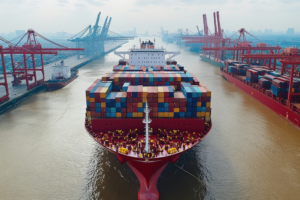AI: The Future Backbone of Logistics
AI is already changing the way logistics operations are managed. From forecasting demand and optimizing delivery routes to identifying disruptions before they happen, AI enables real-time, data-driven decision-making. Machine learning algorithms can process vast amounts of data—weather reports, traffic conditions, port delays, inventory levels—and use it to generate predictive insights that no human could compute in time.
In warehousing, AI enables smarter automation. Robotic systems can now be directed by AI to manage inventory more accurately, pick items faster, and reduce human error. In transportation, route optimization powered by AI significantly reduces fuel costs and delivery times, especially in last-mile logistics. These innovations aren’t just improvements—they’re becoming essential for maintaining a competitive edge.
Preparing for the AI-Powered Supply Chain
For companies looking to stay ahead, preparation is key. First, embracing digitalization is no longer optional. Organizations must move beyond spreadsheets and isolated systems. AI thrives on clean, connected, real-time data. That means companies must invest in platforms that unify logistics data across departments, suppliers, and regions.
Second, flexibility must be built into supply chain strategies. With AI, businesses can model various scenarios and adapt to them instantly. For example, if geopolitical tensions affect trade routes, an AI-enabled system can reroute shipments automatically, minimizing delays and costs. These adaptive systems are the difference between reacting to a crisis and staying ahead of it.
Third, companies must upskill their workforce. While AI handles repetitive tasks, human decision-making is still critical. Training logistics teams to work alongside AI—interpreting its insights and making strategic decisions—will be vital for success in the years ahead.

How Grydd Helps Companies Prepare for the Future
Grydd is at the forefront of AI-driven logistics solutions. As an orchestration platform, it connects every aspect of the supply chain—from procurement and shipping to inventory and customer service—through real-time data and intelligent automation. Grydd’s AI capabilities not only help businesses see what’s happening now but also predict what’s coming next.
With integrated tools for tracking, planning, and risk management, Grydd empowers companies to act faster and smarter—turning uncertainty into opportunity.
Conclusion
The future of logistics is being shaped today by AI-powered technologies. Companies that embrace this shift will gain agility, resilience, and efficiency across their supply chains. But preparation is key. With the right tools, strategies, and mindset, logistics can evolve from a challenge to a competitive advantage.
and boost your Supply Chain Management









